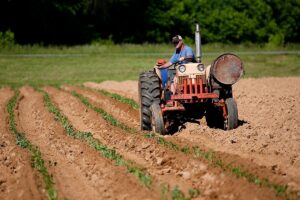The Occupational Safety and Health Administration (OSHA) has issued guidance to protect agricultural workers from exposure to the coronavirus.
The guidance includes recommended actions to account for the unique challenges of agricultural work, such as shared worker housing and shared transport.
OSHA acknowledges that farm operations can vary across regions of the country. The administration also noted that the guidance should be used as a template of action to protect against COVID-19.
Agricultural employers should adapt these recommendations to their own work sites or specific work operations.
Key Takeaways for Agriculture Employers
- Screen agricultural workers for coronavirus symptoms, manage workers who have symptoms upon arrival at work or who become sick during the day, and address return to work after worker exposure.
- Use touch-free clocks and automatic doors, install plastic barriers when distances of six feet between individuals are not possible, and rearrange chairs and tables in break areas.
- Implement cleaning, disinfection, and sanitation protocols.
- Group workers together into cohorts, which may reduce the spread of COVID-19 transmission in the workplace by minimizing the number of different individuals who come into close contact with each other over the course of a week, and may also reduce the number of workers quarantined because of exposure to the virus.
- Maximize opportunities to place farm-workers residing together in the same vehicles for transportation and in the same cohorts to limit exposure.
- Provide basic information and training about infection prevention to all farm workers in languages they can understand.
- Agriculture work sites developing plans for continuing operations where COVID-19 is spreading among workers or in the surrounding community should work directly with appropriate state and local public health officials and occupational safety and health professionals.
Other Guidance for Agriculture Workers
Workers on farms, ranches, and other productions have been exempt from state-wide lock-downs, as they are considered critical infrastructure workers within the food and agriculture section. That’s why it is essential for employers and employees to follow these guidelines as closely as possible.
Employers should also look to the CDC’s Critical Infrastructure Guidance, and guidance from regulatory bodies such as the Food and Drug Administration, as needed.
See the following resources for more industry-specific guidelines to protect against COVID-19:
***
About Worksite Medical
In most cases, OSHA requires medical surveillance testing, and at no cost to employees.
Worksite Medical makes that program easier with mobile medical testing.
We conduct on-site respirator fit tests (including N95 masks), as well as pulmonary function tests and heavy metal lab work, right on your job site. We also keep accurate, easy-to-access medical records for your convenience. You’ll keep your employees at work, and stay ahead of OSHA inspections.
With Worksite Medical, a mobile medical testing unit — we can bring all the resources of a lab to you. Our certified lab technicians can perform both qualitative and quantitative respirator tests to ensure a perfect fit.
Protect your team and your workplace now with Worksite Medical. Not sure what you need? Try our medical testing wizard here.
Give us a call at 1-844-622-8633, or complete the form below to schedule an on-site visit or to get your free quote!




